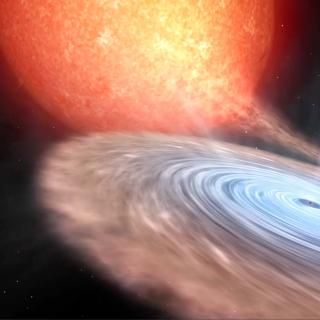Bibcode
Paice, J. A.; Gandhi, P.; Charles, P. A.; Dhillon, V. S.; Marsh, T. R.; Buckley, D. A. H.; Kotze, M. M.; Beri, A.; Altamirano, D.; Middleton, M. J.; Plotkin, R. M.; Miller-Jones, J. C. A.; Russell, D. M.; Tomsick, J.; Díaz-Merced, W.; Misra, R.
Referencia bibliográfica
Monthly Notices of the Royal Astronomical Society, Volume 488, Issue 1, p.512-524
Fecha de publicación:
9
2019
Número de citas
17
Número de citas referidas
12
Descripción
We present rapid, multiwavelength photometry of the low-mass X-ray
binary Swift J1357.2-0933 during its 2017 outburst. Using several sets
of quasi-simultaneous ULTRACAM/NTT (optical), NuSTAR (X-ray), XRT/Swift
(X-ray), SALT (optical), and ATCA (radio) observations taken during
outburst decline, we confirm the frequent optical dipping that has
previously been noted both in outburst and in quiescence. We also find:
(1) that the dip frequency decreases as the outburst decays, similar to
what was seen in the previous outburst, (2) that the dips produce a
shape similar to that in binary systems with partial disc occultations,
(3) that the source becomes significantly bluer during these dips,
indicating an unusual geometry compared to other LMXB dippers, and (4)
that dip superposition analysis confirms the lack of an X-ray response
to the optical dips. These very unusual properties appear to be unique
to Swift J1357.2-0933, and are likely the result of a high binary
inclination, as inferred from features such as its very low outburst
X-ray luminosity. From this analysis as well as X-ray/optical timing
correlations, we suggest a model with multicomponent emission/absorption
features with differing colours. This could include the possible
presence of a sporadically occulted jet base and a recessed disc. This
source still hosts many puzzling features, with consequences for the
very faint X-ray transients population.
Proyectos relacionados

Agujeros negros, estrellas de neutrones, enanas blancas y su entorno local
Los agujeros negros y estrellas de neutrones en binarias de rayos-X son laboratorios únicos para explorar la física de estos objetos compactos. No solo permiten confirmar la existencia de agujeros negros de origen estelar a través de mediciones dinámicas de sus masas, sino que también permiten investigar el comportamiento de la materia y la
Montserrat
Armas Padilla